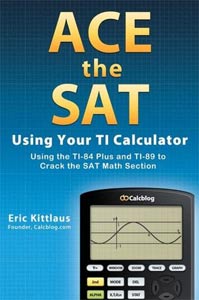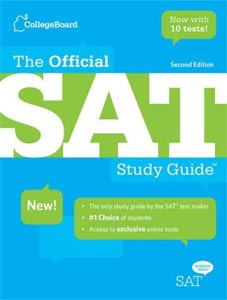There are a lot of misconceptions about calculator use on the SAT. This article covers some basic strategies on how to use your calculator “smarter.” It also attempts to dispel some of the myths you’ve probably heard about calculators and test prep, such as the idea that a calculator won’t help you improve your math and test scores, (studies show this is false) or ideas about how useful calculator programs can be. Read on to learn more about how to get the most out of your SAT prep experience.
First, let’s start with the most common myth you’ve probably heard about calculators and the SAT.
Myth: Using a calculator on the SAT will slow you down and isn’t helpful for most problems.
Truth: This myth is a result of most people not knowing how to use a graphing calculator well. Of course, if you go in on the day of the test without having used your calculator before, it’ll be about as useful as a brick. One place I hear this myth a lot is from so called test prep “experts.” Of course, there are people who are able to do just fine on the SAT without using a calculator, though this is about as efficient as typing with your elbows. If you talk to students who succeeded on the SAT, the vast majority will say that their calculator was helpful. The truth is that nobody from College Board is going to tell you that the best way to do well on the SAT is to use your calculator when it’s supposed to be a test which is evaluating your so-called “mathematical reasoning.”
It’s true that sometimes there is no magic calculator method to solve a problem, though these problems are in the minority: logic problems, geometry problems, and most chart reading problems are questions that are more efficiently done by hand. Of course, even for problems where your calculator can be helpful, it’s worth practicing doing them by hand so that you can practice your problem solving intuition. Ultimately, the most important skill to develop for test taking is an ability to choose the correct tool for solving problems, and with practice this skill will become almost effortless. This doesn’t mean that every problem is best solved by hand. If you’re not using your calculator well, you’re losing out on a powerful tool available to you. With all this in mind, consider the following tips and strategies when studying for the SAT:
Top 10 SAT Study Strategies (in no particular order)
- Many of the types of problems on the SAT are reused over and over again—the more you practice, the more familiar these problems will seem to you. Examples include problems relating ages of people, discount/sale problems, and problems relating rates. These all appear on almost every edition of the SAT.
- Don’t just assume that problems will follow the same patterns you followed in math class. Questions on the SAT test your ability to solve problems above your ability to remember formulae. Ex.: The quadratic formula is almost never useful.
- One problem many people face is not having enough time to complete each section. If you have this issue, you absolutely must take practice tests—College Board offers a book with ten of them. Not only will practice make you faster, but it well help you to make fewer mistakes and familiarize you with the types of problems asked. When I first practiced the SAT, it took me more than the alotted time to finish an SAT math question. By the time I took the actual test, I was able to finish each one in about one third of the given time.
- Another critical reason to learn to work the problems faster is that it’s important to check your work. Almost everyone makes one or two mistakes (or more) as they work through a section, and it’s necessary to check all your answers to avoid making careless mistakes. When you’re checking work, try not to look at your old work, but rather rework the problems you can over again.
- Learn to use your calculator well. This involves running through SAT practice sections while using your calculator. At first it might seem a bit unnatural, but as you practice, it will help you improve your speed and accuracy.
- When doing numerical calculations, try to do them both by hand (or mentally) and on your calculator. This reduces the chance of careless arithmetic errors such as “2 + 2 = 2” and the like.
- As you practice with your calculator, you will learn more advanced calculator tricks which will help you solve problems beyond just simple calculations. This is where the calculator is most useful. Calculators such as the TI-84 Plus and TI-89 have features for dealing with fractions, solving equations, dealing with sequences and sums, and much more.
- When practicing, try to categorize problems by whether or not you’ll need to use your calculator, what information you’ll need to determine the answer, and what the exam is trying to test.
- If you aren’t sure how to answer a question, skip it and come back at the end—your brain will have a chance to work on it in the background while you’re trying further problems. Remember that if you can eliminate a few of the answers, however, it’s usually a good idea to guess if you don’t think you can make any more progress. Always check your answers to make sure they make sense.
- Again, study. There is literally nothing you can lose from more practice. Maybe you’re disillusioned with the whole process of standardized testing, but it is still really important to your future, and more practice can only help. If you get a really great score, then there’s even the possibility of getting scholarships worth tens or even hundred of thousands of dollars worth of scholarships. Isn’t that worth a few weeks of your life?

Keep your eye on the prize.
Other Common Myths
So now that you have an idea of what you need to do to succeed on the SAT math section, what kind of mindset should you be in, and what should you expect from using your calculator? Let’s take a look at a few more myths about calculators, and then talk more about how to get the most out of yours.
Myth: Using a calculator is a crutch which makes people poor learners.
Truth: Studies actually support the fact that using a calculator helps students to learn new math concepts more easily. On top of that, using a calculator helps to make doing math faster (especially for algebra and brute force work) and can eliminate mistakes. While it doesn’t make sense to use a calculator when learning addition or subtraction, by the time students are in high school, they learn to use a calculator intelligently and in ways which help improve problem solving skills while not worrying about numerical difficulties.
Myth: Using calculator programs can greatly improve your SAT score.
Truth: I’ve seen numerous ads purporting to sell calculator programs which will “boost your SAT score” and “give you all the answers.” This advertising tries to make it seem like all you need to do is buy their product and your life will instantly become better, but by now I’m sure you realize that nothing in life is that easy, and these programs are no exception. While most SAT problems follow the same patterns, it’s so rare that you will see the same exact problem twice that it’s completely unreasonable to have a program for each problem type. Even programs which store useful formulas are typically useless, since every formula you need on the SAT is conveniently placed in a box at the top of the section.
Even if there were such a magic program and one had practiced enough to use their calculator effectively, it would take them longer to read the question and operate the program than it would to do it using more hybrid methods. Ultimately, your calculator can’t do all your thinking for you. Rather, you need to learn how to use your calculator well and adapt your methods to each problem.
Myth: Using a calculator doesn’t help students do better on the SAT.
Truth: In high school and college, I’ve known hundreds of people who have taken the SAT and other standardized tests, and they fit into three categories.
- 20% are people who don’t study for the SAT and do either well or poorly, though usually aren’t the top scorers.
- 65% are people who study for the SAT or take prep classes and end up not doing especially well, whether they’re great or poor students.
- The last 15% are people who may or may not be good students, but they study a moderate amount and do quite well.
So what’s the difference between the second and third groups? Almost universally, the difference I’ve seen is in the way people study. The people who studying doesn’t help are the people who are either forced to study by their parents and don’t really care much about the outcome/their future, or those who don’t study smart. In any case, these people may put in the hours but don’t really try to learn from their mistakes.
On the other hand, the people who succeed consistently try to learn from their mistakes, looking at each problem they missed and figuring out why, then trying again. They don’t always put in the most hours, but they don’t give up on a problem until they know that they could do it if they saw it again, and they start to learn exactly what kinds of problems are asked on the test.
You may see where I’m going by now—the point is that the people who say a calculator doesn’t help on the SAT are a combination of the 2/3 of people who study but don’t succeed and the educators and test prep “experts” who have never picked up a graphing calculator in their lives. Even out of people who do know how to study smart, the vast majority don’t know how to use their calculator effectively—if you can master your calculator and spend the time to practice smart, you’ll already be in the top few percent of test takers and well on your way to your dream school.
TI-84 Plus and TI-89
The TI-84 Plus offers advanced graphing, statistics, and scientific functions. Its sibling, the TI-89, offers a wide slew of symbolic math functions, calculus tools, and the ability to graph in 3D.
Which Calculator Should I Use?
Generally, I’d recommend the TI-84 Plus or TI-89. The former is a bit easier to learn but not as powerful as the TI-89. It also doesn’t have as many calculus functions, though these aren’t useful for the SAT. If you’re planning studying math, science, or engineering, I’d probably go with the TI-89—it’s still better than many of the computer resources available. These calculators are the most commonly used and are probably recommended or required for your high school math courses as well. Other calculators, such as many models by HP, have similar functionality and are also hugely useful, but there isn’t as much documentation available on them. All of these calculators are much more useful than simple four-function or scientific calculators, and are more than worth the extra money.
Once you have your calculator, be sure to practice using it, as I advocated above. This article provided some basic strategies, but doesn’t really do justice to the wide variety of problems which can be simplified using a good graphing calculator. If you’d like to learn more, check out our other SAT prep articles, or pick up a copy of our book, Ace the SAT Using Your TI Calculator. It’s less than $11, which is the price of a cheap lunch, and is packed with information on how to crack the SAT and get into the college of your dreams.




